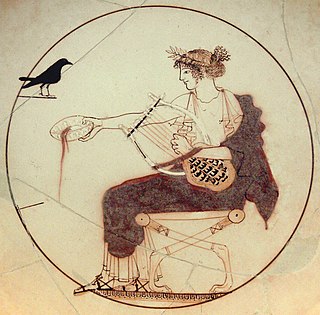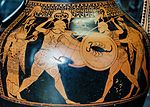
Black-figure pottery painting, also known as the black-figure style or black-figure ceramic is one of the styles of painting on antique Greek vases. It was especially common between the 7th and 5th centuries BC, although there are specimens dating as late as the 2nd century BC. Stylistically it can be distinguished from the preceding orientalizing period and the subsequent red-figure pottery style.

Exekias was an ancient Greek vase-painter and potter who was active in Athens between roughly 545 BC and 530 BC. Exekias worked mainly in the black-figure technique, which involved the painting of scenes using a clay slip that fired to black, with details created through incision. Exekias is regarded by art historians as an artistic visionary whose masterful use of incision and psychologically sensitive compositions mark him as one of the greatest of all Attic vase painters. The Andokides painter and the Lysippides Painter are thought to have been students of Exekias.

Red-figure vase painting is one of the most important styles of figural Greek vase painting.
Kleitias was an ancient Athenian vase painter of the black figure style who flourished c. 570–560 BCE. Kleitias' most celebrated work today is the François Vase, which bears over two hundred figures in its six friezes. Painted inscriptions on four pots and one ceramic stand name Kleitias as their painter and Ergotimos as their potter, showing the craftsmen's close collaboration. A variety of other fragments have been attributed to him on a stylistic basis.

Nikosthenes was a potter of Greek black- and red-figure pottery in the time window 550-510 BC. He signed as the potter on over 120 black-figure vases, but only 9 red-figure. Most of his vases were painted by someone else, called Painter N. Beazley considers the painting "slovenly and dissolute;" that is, not of high quality. In addition, he is thought to have worked with the painters Anakles, Oltos, Lydos and Epiktetos. Six's technique is believed to have been invented in Nikosthenes' workshop, possibly by Nikosthenes himself, around 530 BC. He is considered transitional between black-figure and red-figure pottery.

Epiktetos was an Attic vase painter in the early red-figure style. Besides Oltos, he was the most important painter of the Pioneer Group. He was active between 520 BC and 490 BC. His name translates as "newly acquired" which is most probably a reference to his slave status.

Psiax was an Attic vase painter of the transitional period between the black-figure and red-figure styles. His works date to circa 525 to 505 BC and comprise about 60 surviving vases, two of which bear his signature. Initially he was allocated the name Menon Painter by John Beazley. Only later was it realised that the artist was identical with the painters signing as Psiax.

White-ground technique is a style of white ancient Greek pottery and the painting in which figures appear on a white background. It developed in the region of Attica, dated to about 500 BC. It was especially associated with vases made for ritual and funerary use, if only because the painted surface was more fragile than in the other main techniques of black-figure and red-figure vase painting. Nevertheless, a wide range of subjects are depicted.

The Amasis Painter was an ancient Greek vase painter who worked in the black-figure technique. He owes his name to the signature of the potter Amasis, who signed 12 works painted by the same hand. At the time of the exhibition, "The Amasis Painter and His World" (1985), 132 vases had been attributed to this artist.
The Lysippides Painter worked in Athens in the second half of the 6th century BC. He was a black-figure painter of a classic style. He most probably trained with Ezekias in his workshop until moving to the Andokides workshop where he mainly painted large, expensive vases and did some work on bilingual vases with Andokides P being the red-figure painter. He was named, after much debate ensuring he was not the Andokides Painter using red-figure, after a Kalos found on one of his vases.

The Belly Amphora in the Staatliche Antikensammlungen at Munich is one of the most famous works by the Andokides Painter. The vase measures 53.5 cm high and 22.5 cm in diameter. It dates to between 520 and 510 BC and was discovered at Vulci. It was acquired by Martin von Wagner, an agent of Ludwig I of Bavaria.

Amasis was an ancient Attic potter, active in Athens between 560/550 and 530/520 BC. Amasis’s pottery workshop also employed a well-known painter, who is conventionally named the Amasis Painter after the potter, and generally considered as one of the best Archaic vase painters. His works are mostly black-figure, but some red-figure vase paintings by him do occur. He and Exekias produced the first major painted amphorae with a narrative image on front and back, respectively. Famous works:

A Siana cup is a type of Attic cup decorated in the black-figure technique. They are named after one of their find locations, the Necropolis of the ancient city of Siana on Rhodes. During the second quarter of the 6th century BC, Siana cups were the predominant cup shape in Athens. The shape remained popular later and was still being produced in large quantities during the era of the Little-master cups.
Elbows Out is the name given to an Attic black-figure vase painter, active in Athens around 550/540 to 520 BC. His conventional name is derived from the strongly exaggerated gestures and odd anatomy of his dancing figures. Together with the Affecter, he is considered one of the mannerists of the black-figure style. He painted e.g. lip cups and neck amphorae, the latter in a special shape with a heavy ovoid body. His amphorae are decorated with several friezes. His band cups resemble works by Tleson and Lydos, but are more conventional in terms of the animal motifs. He also painted a lydion, a vase shape very rarely produced by Attic potters. He is often seen as connected with the Affecter, but also with the Amasis Painter. The link with the latter should not be overestimated.

Bilingual vase painting is a special form of ancient Greek vase painting. The term, derived from linguistics, is essentially a metaphorical one; it describes vases that are painted both in the black-figure and in the red-figure techniques. It also describes the transitional period when black-figure was being gradually replaced in dominance by red-figure, basically the last quarter of the 6th and the very beginning of the 5th century BC. Their appearance may be due to the initial uncertainty of the market for the new red-figure style, although that style subsequently became dominant rather fast.

The Lysippides Painter was an Attic vase painter in the black-figure style. He was active around 530 to 510 BC. His real name is not known.

The Mastos Painter was a painter of ancient Greek vases. He is named for a black-figure mastos used by the art historian John Boardman to illustrate the type, which is shaped like a woman's breast.
Beth Cohen is an American classical archaeologist. She studied under German-American art historian Dietrich von Bothmer at the Institute of Fine Arts of New York University where she received her doctorate on bilingual vase painting of Ancient Greece. Her dissertation, Attic Bilingual Vases and their Painters is the main book used in the study of bilingual vase painting. Cohen became a specialist in the field of Greek vase painting, especially on rare forms of Attic vase painting. She organized the 2006 exhibition The colors of clay. Special techniques in Athenian vases at J. Paul Getty Museum in Malibu.

The bilingual eye cup by the Andokides painter in the Museo Archeologico Regionale, Palermo, is a prime example of the transition from black-figure vase painting to the red-figure style in the late 6th century to early 5th century that commonly resulted in "bilingual" vases, using both styles. The Andokides painter created the red-figure style of pottery as we know it today during his working years from 530-515 BC. Starting around 530 BC the Andokides painter produced red-figure amphorae and a bilingual kylix. Fewer than 20 vases survive by the Andokides painter but they span 30-40 years of his career, allowing historians to trace the development of his painting styles. One of the earliest mentions of the Andokides painter was on a black-figure hydria by Timagoras around 550 BC, when the Andokides painter must have been an apprentice.

Elizabeth Simpson is an archaeologist, art historian, illustrator, and Professor Emerita at the Bard Graduate Center, New York, NY, where she taught for 25 years. She is director of the project to study, conserve, and publish the large collection of rare wooden artifacts from Gordion, Turkey, which date to the eighth century B.C. In this capacity, she is a consulting scholar in the Mediterranean Section, University of Pennsylvania Museum of Archaeology and Anthropology, Philadelphia. She received her PhD in Classical Archaeology from the University of Pennsylvania in 1985.





















